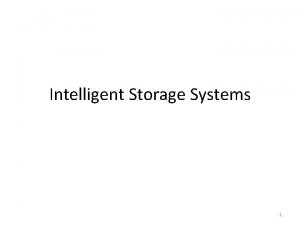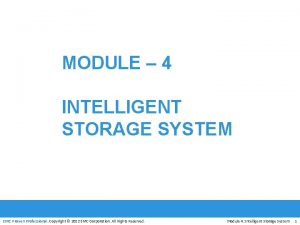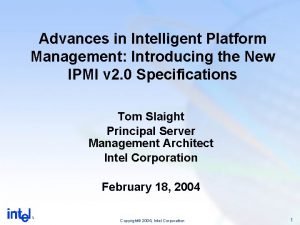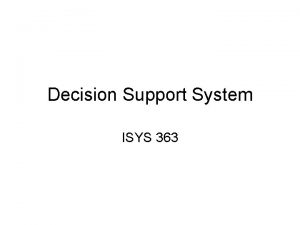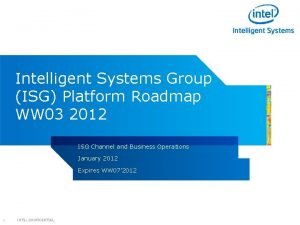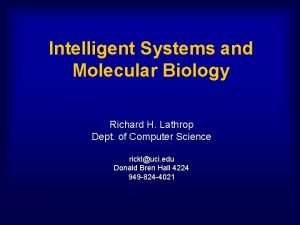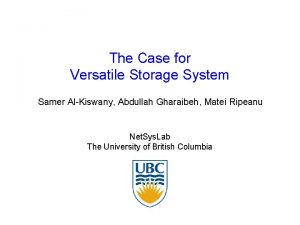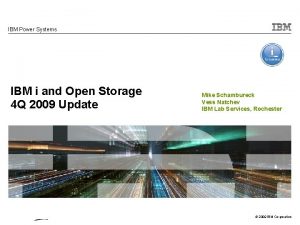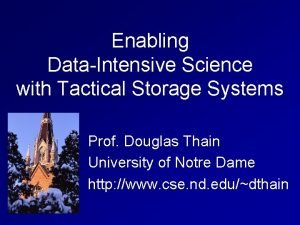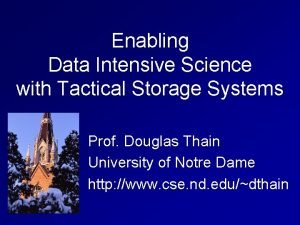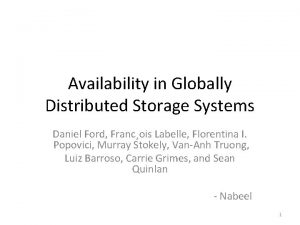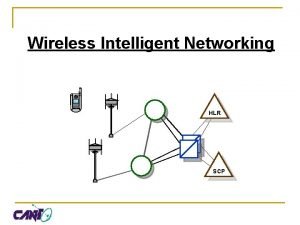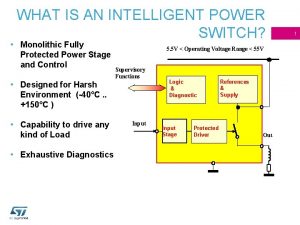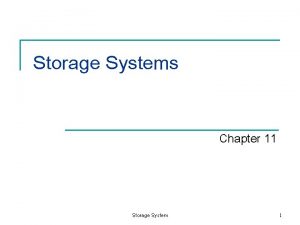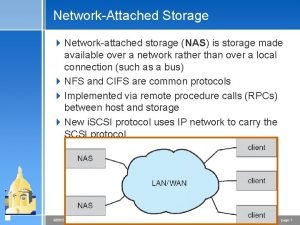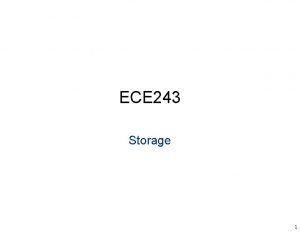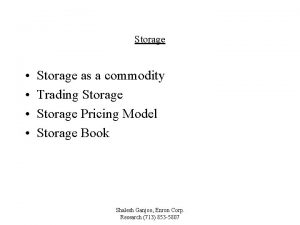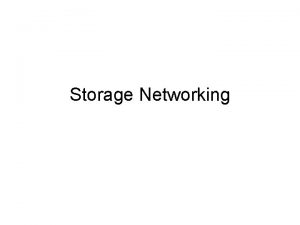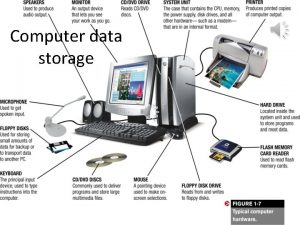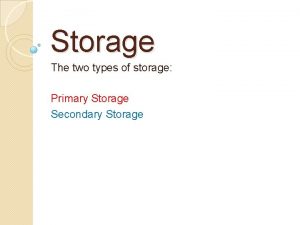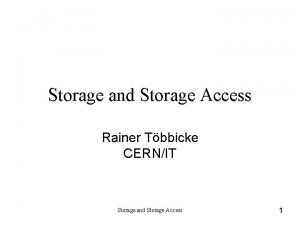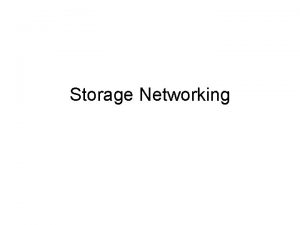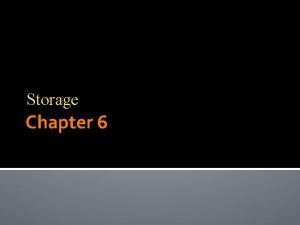Intelligent Storage Systems 1 What is an Intelligent























- Slides: 23

Intelligent Storage Systems 1

What is an Intelligent Storage Systems are RAID arrays that are: • Highly optimized for I/O processing • Have large amounts of cache for improving I/O performance • Have operating environments that provide: – Intelligence for managing cache – Array resource allocation – Connectivity for heterogeneous hosts – Advanced array based local and remote replication options ISMDR: BE 5 IT: VIII: Madhu N. PIIT 2

Benefits of an Intelligent Storage System Intelligent storage system provides several benefits over a collection of disks in an array (JBOD) or even a RAID arrays: – Increased capacity – Improved performance – Easier data management – Improved data availability and protection – Enhanced Business Continuity support – Improved security and access control ISMDR: BE 5 IT: VIII: Madhu N. PIIT 3

Components of an Intelligent Storage System Host Front End Back End Physical Disks Cache Connectivity FC SAN ISMDR: BE 5 IT: VIII: Madhu N. PIIT 4

Intelligent Storage System: Front End Intelligent Storage System Host Front End Back End Physical Disks Cache Connectivity FC SAN Ports Controllers ISMDR: BE 5 IT: VIII: Madhu N. PIIT 5

Front End • provides the interface between the storage system and the host • two components: front-end ports and front-end controllers • ports enable hosts to connect to the intelligent storage system- processing logic that executes the appropriate transport protocol- high availability. • controllers route data to and from cache receives write data, the controller sends an acknowledgment message. optimize I/O processing by using command queuing algorithms.

Front-End Command Queuing • determines the execution order of received commands and can reduce unnecessary drive head movements and improve disk performance • Command -- controller(alg)-- assigns tag(seq of execution) • First In First Out (FIFO) • Seek Time Optimization • Access Time optimization

Front End Command Queuing A D C B A D I/O Requests C B A I/O Processing Order C D B Front-End Controller Cylinders Without Optimization (FIFO) A D C B A D I/O Requests B C A I/O Processing Order Front-End Controller With command queuing ISMDR: BE 5 IT: VIII: Madhu N. PIIT C D B Cylinders 8

Intelligent Storage System: Cache Intelligent Storage System Front End Host Back End Physical Disks Cache Connectivity FC SAN ISMDR: BE 5 IT: VIII: Madhu N. PIIT 9

Read Operation with Cache: ‘Hits’ and ‘Misses’ Data found in cache = ‘Hit’ Read Request Cache No data found = ‘Miss’ Cache Read Request ISMDR: BE 5 IT: VIII: Madhu N. PIIT 10

Write Operation with Cache Write-through Cache Write Request Acknowledgement Write-back Cache Write Request Acknowledgement ISMDR: BE 5 IT: VIII: Madhu N. PIIT 11

Write Operation with Cache • Write aside Size-bypassing cache. • provide performance advantages ISMDR: BE 5 IT: VIII: Madhu N. PIIT 12

Cache Management: Algorithms New Data • finite and expensive resource that needs proper management • Least Recently Used (LRU) – Discards least recently used data • Most Recently Used (MRU) – Discards most recently used data ( assumed that recent data may not be required for a while ) Oldest Data Cache Implementation Dedicated Cache – Separate memory sets reserved for read and write Global Cache – Both read and write operation use available memory. – More efficient- only one global set of addresses has to be managed. ratio of cache available for reads versus writes is dynamically adjusted based on the workloads. ISMDR: BE 5 IT: VIII: Madhu N. PIIT 13

Cache Management: Watermarking I/O access rate and pattern, high and low levels called watermarks are set in cache to manage the flushing Manage peak I/O requests “bursts” through flushing/de-staging. Flushing is the process of committing data from cache to the disk. – Idle flushing, High Watermark flushing and Forced flushing For maximum performance: – Provide headroom in write cache for I/O bursts 100 % HWM LWM Idle flushing High watermark flushing Forced flushing ISMDR: BE 5 IT: VIII: Madhu N. PIIT

Cache Data Protection • Protecting cache data against failure: (power failure) – Cache mirroring • Each write to the cache is held in two different memory locations on two independent memory cards • Cache coherency(only writes r mirrored) – Cache vaulting • Cache is exposed to the risk of uncommitted data loss due to power failure • In the event of power failure, uncommitted data is dumped to a dedicated set of drives called vault drives ISMDR: BE 5 IT: VIII: Madhu N. PIIT 15

Intelligent Storage System: Back End Intelligent Storage System Host Front End Back End Physical Disks Cache Connectivity FC SAN Controllers ISMDR: BE 5 IT: VIII: Madhu N. PIIT Ports 16

Intelligent Storage System: Physical Disks Intelligent Storage System Host Front End Back End Physical Disks Cache Connectivity FC SAN ISMDR: BE 5 IT: VIII: Madhu N. PIIT 17

What the Host Sees – RAID Sets and LUNs (Logical Unit Number) Host 1 Intelligent Storage System Front End LUN 0 Connectivity Back End Cache Physical Disks LUN 0 FC SAN LUN 1 Host 2 ISMDR: BE 5 IT: VIII: Madhu N. PIIT 18

LUN Masking It is a process that provides data access control by defining which LUNs a host can access. • LUN masking is access control mechanism • Process of masking LUNs from unauthorized access • Implemented on storage arrays and at front end controller Intelligent Storage Arrays High End Storage System Mid Range Storage System ISMDR: BE 5 IT: VIII: Madhu N. PIIT 19

• ISS Implementation: High-end Storage Systems Also referred as Active-active arrays – I/O’s are serviced through all the available path Active-Active Configuration Active Host Port Controller B Large storage capacity Huge cache to service host I/Os Fault tolerance architecture Multiple front-end ports and support to interface protocols – High scalability – Ability to handle large amounts of concurrent I/Os – – Controller A • Following are high-end array capabilities: LUN Storage Array • Designed for large enterprises ISMDR: BE 5 IT: VIII: Madhu N. PIIT 20

Midrange Storage Systems Active Port Passive Host ISMDR: BE 5 IT: VIII: Madhu N. PIIT Controller A – Host can perform I/Os to LUNs only through active paths – Other paths remain passive till active path fails • Midrange array have two controllers, each with cache, RAID controllers and disks drive interfaces • Designed for small and medium enterprises • Less scalable as compared to high-end array Active-Passive Configuration Controller B • Also referred as Active-passive arrays LUN Storage Array

Chapter Summary Key points covered in this chapter: • Intelligent Storage Systems features • Components of Intelligent Storage Systems • Cache management algorithms • Intelligent Storage System implementation – High-end storage array – Mid range storage array ISMDR: BE 5 IT: VIII: Madhu N. PIIT 22

Check Your Knowledge • What are the parts of an Intelligent Storage System? • What are the differences between a high-end and midrange storage array? • What is the difference between a read cache hit and a read cache miss? • What is the difference between Least Recently Used and Most Recently Used algorithms? • What is the difference between Write-through and Write-back cache? ISMDR: BE 5 IT: VIII: Madhu N. PIIT 23
 Decision support systems and intelligent systems
Decision support systems and intelligent systems What is an intelligent storage system
What is an intelligent storage system Intelligent storage definition
Intelligent storage definition Primary storage vs secondary storage
Primary storage vs secondary storage Primary storage and secondary storage
Primary storage and secondary storage Secondary storage provides temporary or volatile storage
Secondary storage provides temporary or volatile storage Unified storage vs traditional storage
Unified storage vs traditional storage Intelligent lectern systems
Intelligent lectern systems Ipmi architecture
Ipmi architecture Isys intelligent systems
Isys intelligent systems Hw-q67b
Hw-q67b Intelligent systems for molecular biology
Intelligent systems for molecular biology Samer al-kiswany
Samer al-kiswany Storage for ibm power systems
Storage for ibm power systems Tactical storage systems
Tactical storage systems Tactical storage systems
Tactical storage systems Availability in globally distributed storage systems
Availability in globally distributed storage systems Engineering elegant systems: theory of systems engineering
Engineering elegant systems: theory of systems engineering Embedded systems vs cyber physical systems
Embedded systems vs cyber physical systems Elegant systems
Elegant systems Any time interrogation call flow
Any time interrogation call flow Intelligence vs intelligent
Intelligence vs intelligent Intelligent power switch
Intelligent power switch What is an intelligent sharing of power
What is an intelligent sharing of power

